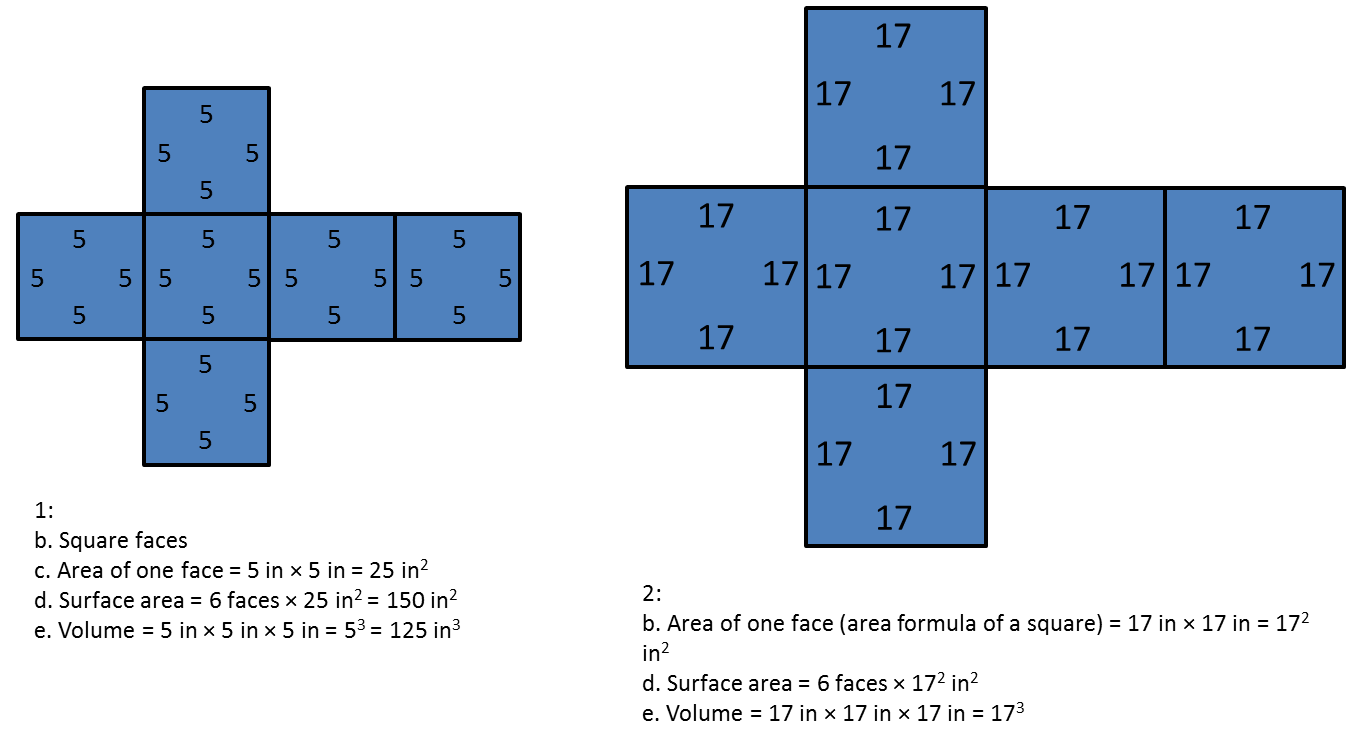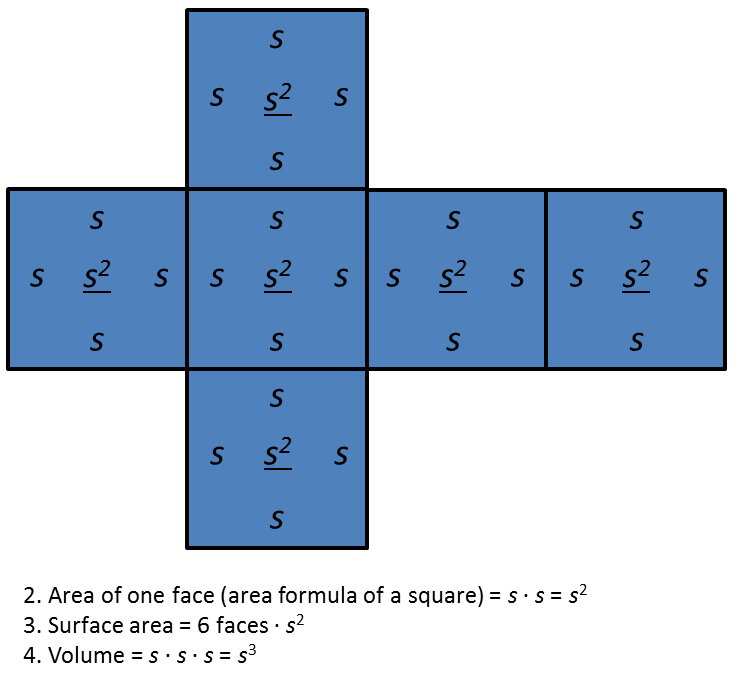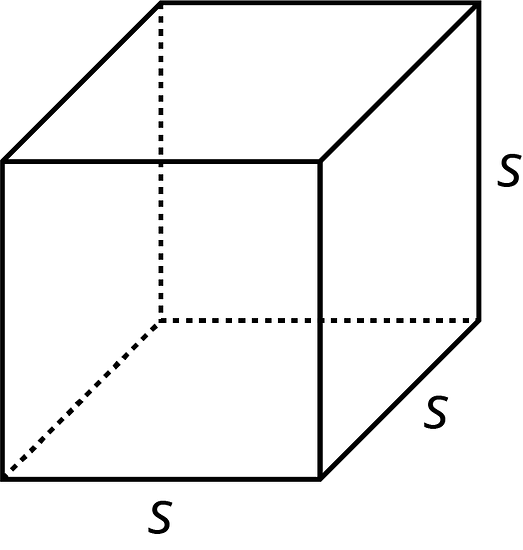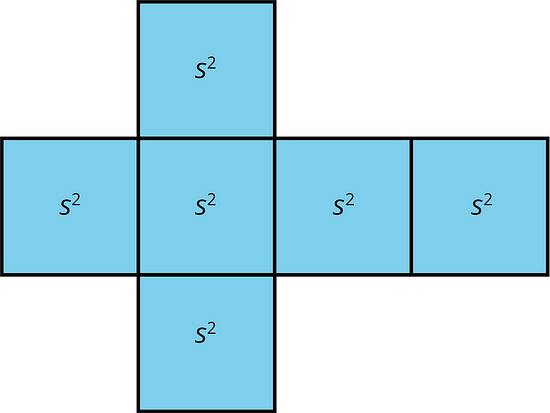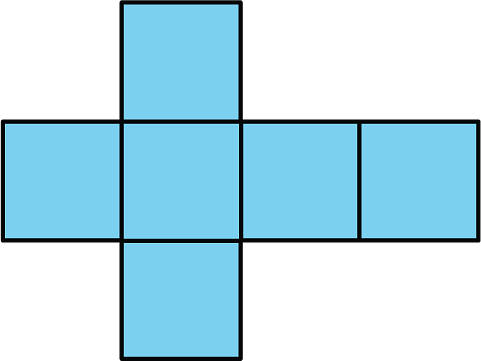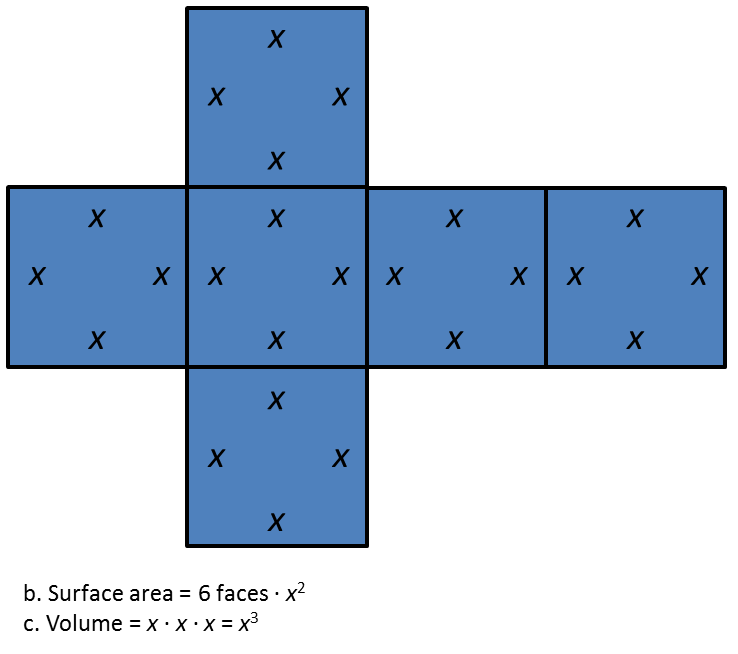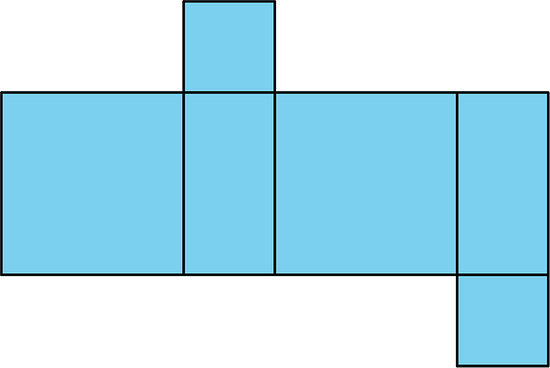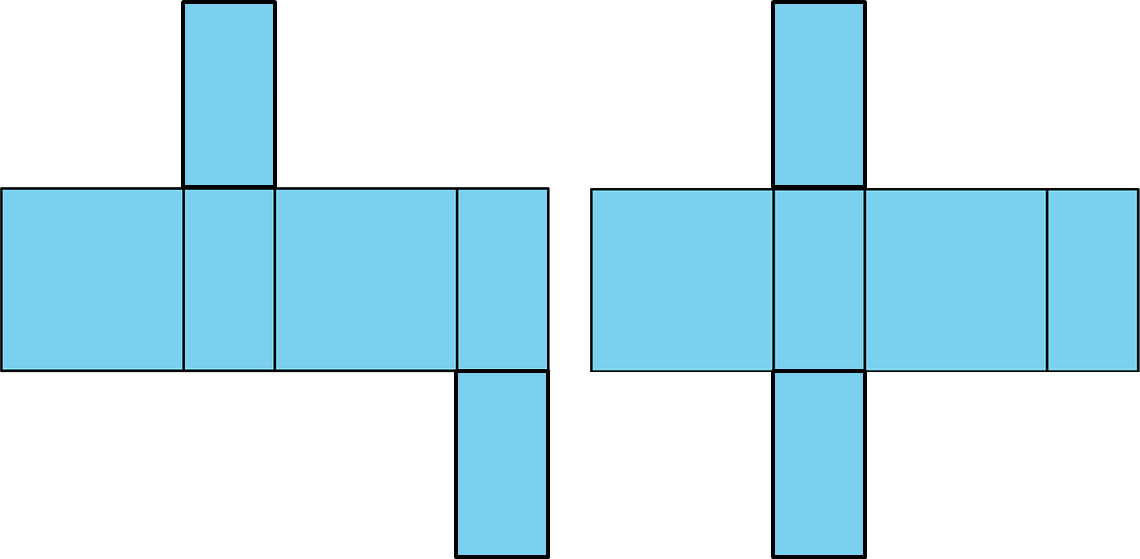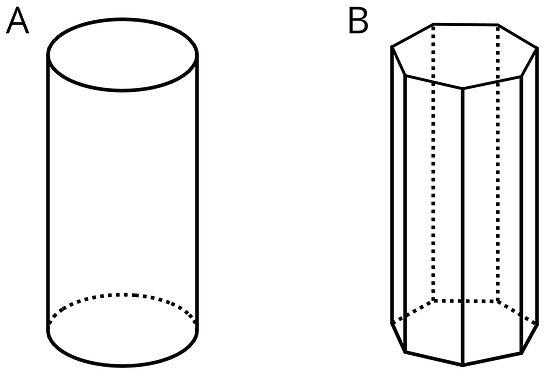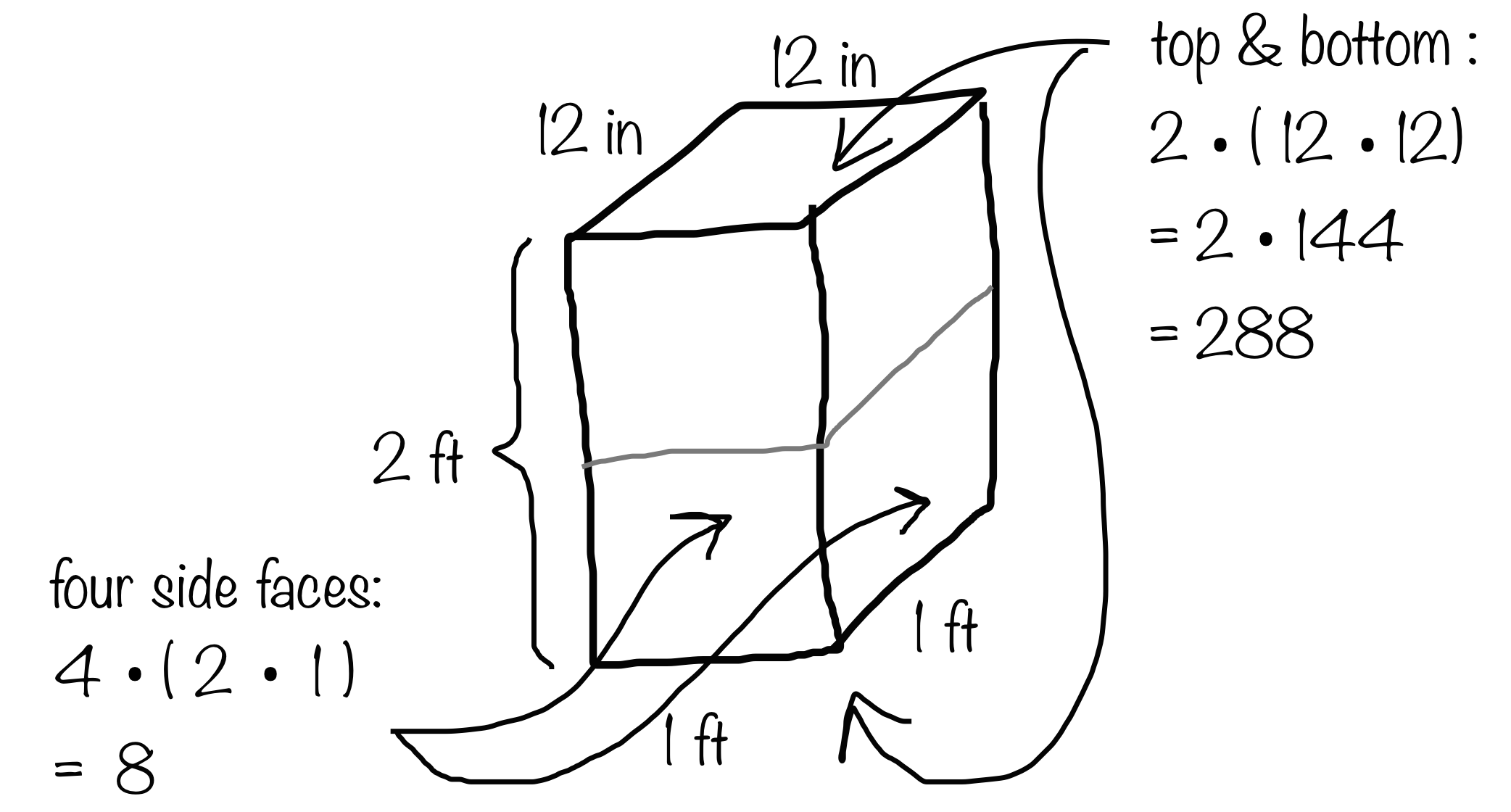

Illustrative Mathematics Unit 6.1, Lesson 18: Squares and Cubes
Related Topics:
Math Worksheets
Learn how to write and explain the formula for the surface area of a cube. After trying the questions, click on the buttons to view answers and explanations in text or video.
Return to the list of Illustrative Math lessons
Surface Area of a Cube
Let’s write a formula to find the surface area of a cube.
Illustrative Math Unit 6.1, Lesson 18 (printable worksheets)
18.1 - Exponent Review
Select the greater expression of each pair without calculating the value of each expression. Be prepared to explain your choices.
a. 10 · 3 or 103
b. 132 or 12 · 12
c. 97 + 97 + 97 + 97 + 97 + 97 or 5 · 97
-
Answers
a. 103.
103 is 10 · 10 · 10, which is greater than 10 · 3.b. 132.
132 is 13 · 13, which is greater than 12 · 12.c. 97 + 97 + 97 + 97 + 97 + 97.
This expression is equal to 6 · 97, which is greater than 5 · 97. -
See Video 1 for Whole Lesson
-
See Video 2 for Whole Lesson
18.2 - The Net of a Cube
1. A cube has edge length 5 inches.
- Draw a net for this cube, and label its sides with measurements.
- What is the shape of each face?
- What is the area of each face?
- What is the surface area of this cube?
- What is the volume of this cube?
2. A cube has edge length 17 units.
- Draw a net for this cube, and label its sides with measurements.
- Explain why the area of each face of this cube is 172 square units.
- Write an expression for the surface area, in square units.
- Write an expression for the volume, in cubic units.
-
See Possible Answers

1. b. Square faces
c. Area of one face = 5 in × 5 in = 25 in2
d. Surface area = 6 faces × 25 in2 = 150 in2
e. Volume = 5 in × 5 in × 5 in = 53 = 125 in32. b. Area of one face (area formula of a square) = 17 in × 17 in = 172 in2
c. Surface area = 6 faces × 172 in2
d. Volume = 17 in × 17 in × 17 in = 173
18.3 - Every Cube in the Whole World
A cube has edge length s.
1. Draw a net for the cube.
2. Write an expression for the area of each face. Label each face with its area.
3. Write an expression for the surface area.
4. Write an expression for the volume.
-
See Possible Answers

2. Area of one face (area formula of a square) = s · s = s2
The area of each face is underlined.3. Surface area = 6 faces · s2
4. Volume = s · s · s = s3
Lesson 18 Summary
The volume of a cube with edge length s is s3.
A cube has 6 faces that are all identical squares. The surface area of a cube with edge length s is 6 · s2.
Practice Problems
1. a. What is the volume of a cube with edge length 8 in?
b. What is the volume of a cube with edge length ⅓ cm?
c. A cube has a volume of 8 ft3. What is its edge length?
-
Answers
a. 83 in3 = 512 in3
b. (⅓)3 cm3 = 1⁄27 cm3
c. 23 ft3 = 8 ft3
2 ft is the edge length.
2. a. What three-dimensional figure can be assembled from this net?
b. If each square has a side length of 61 cm, write an expression for the surface area and another for the volume of the figure.
-
Answers
a. This net can be assembled into a cube.
b. Surface area = 6(612) cm2
Volume = 613 cm3
3. a. Draw a net for a cube with edge length x cm.
b. What is the surface area of this cube?
c. What is the volume of this cube?
-
Answers
a.

b. Surface area = 6 faces · x2
c. Volume = x · x · x = x3
4. Here is a net for a rectangular prism that was not drawn accurately.
a. Explain what is wrong with the net.
b. Draw a net that can be assembled into a rectangular prism.
c. Create another net for the same prism.
-
See Possible Answers
a. The square faces are too small to match the entire edge of the large rectangles when the net is folded.
b and c.

5. State whether each figure is a polyhedron. Explain how you know.
-
Answers
A is not a polyhedron, while B is a polyhedron. A is a cylinder, which has non-polygonal faces. B is a heptagonal prism and all its faces are polygons.
6. Here is Elena’s work for finding the surface area of a rectangular prism that is 1 foot by 1 foot by 2 feet.
She concluded that the surface area of the prism is 296 square feet. Do you agree with her conclusion? Explain your reasoning.
-
Answers
Elena is incorrect. The dimensions of the top face have been labeled in inches, which is a different unit from the rest of the labels. Values calculated in square inches (the total area of the top and bottom faces in Elena's sketch and calculations = 288 in2) cannot be added to values calculated in square feet (the total area of the 4 side faces in Elena's sketch and calculations = 8 ft2).
The Open Up Resources math curriculum is free to download from the Open Up Resources website and is also available from Illustrative Mathematics.
Try out our new and fun Fraction Concoction Game.
Add and subtract fractions to make exciting fraction concoctions following a recipe. There are four levels of difficulty: Easy, medium, hard and insane. Practice the basics of fraction addition and subtraction or challenge yourself with the insane level.



We welcome your feedback, comments and questions about this site or page. Please submit your feedback or enquiries via our Feedback page.
